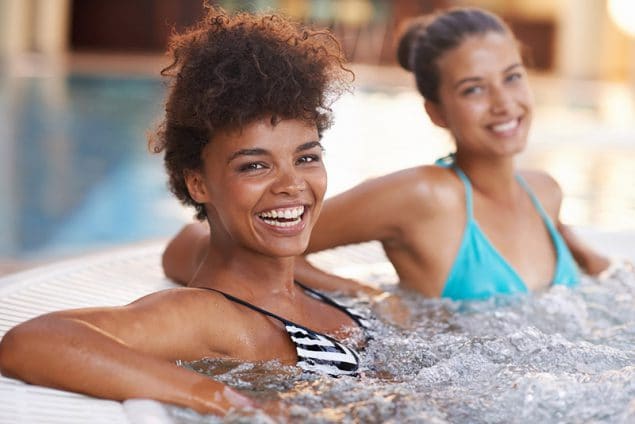Healthy and Safe Swimming Year-Round

We typically think about healthy and safe swimming during the summer months, but a lot of people also swim in the fall, winter, and spring. Many hot tubs and indoor pools are open all year. Learn how to protect yourself and those you care about from illness and injury in and around the water.
Germs can spread through water we swim, play, or relax in and cause illness. Swimmers are at risk for these illnesses if they swallow, have contact with, or breathe in mists or aerosols from water contaminated with germs. Swimmers can also get sick after having contact with chemicals that are in the water or that evaporate from the water and turn into gas in the air.
Stay Healthy in Hot Tubs
Whenever you use a hot tub at someone’s home or that is open to the public, keep the following HOT steps in mind to help keep yourself and others healthy and safe: Heed the rules, Observe your surroundings, and Talk to the operator!
Heed rules for healthy and safe use:
- Don’t swallow the water.
- Stay out of the water if sick with diarrhea.
- Don’t let children less than 5 years old use hot tubs.
- Don’t drink alcohol before or during hot tub use.
- Shower before you get in the water.
- If you are pregnant, talk to a healthcare provider before using a hot tub.
- Keep the number of people in a public hot tub (such as at a hotel or gym) below or at maximum capacity.
Follow CDC’s steps for healthy swimming while swimming, playing, or relaxing in the water.
Observe the hot tub and its surroundings:
- Water temperature should not be higher than 104°F (40°C).
- Check the water for proper disinfectant levels (chlorine or bromine) and pH, using test strips.
- Tiles should not be sticky or slippery.
- A properly chlorinated hot tub has little odor. A strong chemical smell indicates a problem.
Talk to hot tub operators and owners:
- Are chlorine or bromine levels and pH checked at least twice a day?
- Are these levels and pH checked when the hot tub is most heavily used?
- What are the latest inspection results for the hot tub?
- Are staff who are trained in hot tub operation available during the weekends when the hot tub is most heavily used?
- Share the above tips with operators and owners to help prevent illnesses.

Talk to hot tub operators and owners:
- Are chlorine or bromine levels and pH checked at least twice a day?
- Are these levels and pH checked when the hot tub is most heavily used?
- What are the latest inspection results for the hot tub?
- Are staff who are trained in hot tub operation available during the weekends when the hot tub is most heavily used?
- Share the above tips with operators and owners to help prevent illnesses.
Stay Healthy in Indoor Pools
Pools and other places where we swim in chlorinated water shouldn’t have a strong chemical smell. If you notice a strong chemical smell at the pool, you are probably smelling chloramines.
Chloramines form in the water when chlorine combines with pee, poop, sweat, dirt, and skin cells that wash off swimmers’ bodies. After forming in the water, chloramines enter the air and give off a strong chemical smell. Although chloramines can be present at outdoor pools, they are more likely to bother swimmers at indoor pools because there is less ventilation.
Swimmers can get red eyes or nose and throat irritation from chloramines. Help protect yourself and those you care about by taking steps to stop chloramines from forming in the first place. Talk to the pool operator if you notice a strong chemical smell.
Stay Safe in the Water: Take Steps to Prevent Drowning
Drowning kills more children aged 1–4 years than anything else except birth defects. You can take action to prevent drowning:
- Make sure everyone has basic swim skills, such as floating and treading water.
- Have a four-sided fence that goes all the way around the pool and separates it from the house, with self-closing and self-latching gates. Also, remove all toys from the pool area that might attract children to the pool when not in use.
- Supervise swimmers closely at all times.
- Use life jackets in and around pools for children and weaker swimmers.
- Know how to recognize and respond to a swimmer in distress and how to perform cardiopulmonary resuscitation (CPR).